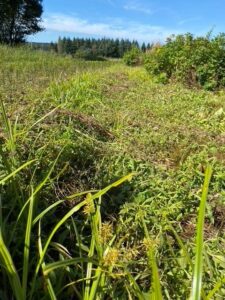 |
Tiger nut | Status LU: unknown. 1st record: 2024, ITW 2024. |
 |
Status Eur.: unknown | |
 |
Souchet comestible | RA: ISEIA: n/a Harmonia+: n/a |
 |
Erdmandel | Wikipedia: |
 |
Knolcyperus | Back to the list of neophytes |
Contents
Report the species
→ Report Cyperus esculentus to the National Museum of Natural History.
Brief description
Cyperus esculentus L. (also called chufa or tiger nut) is a species of plant in the sedge family widespread across much of the world. It is found in most of the Eastern Hemisphere, including Southern Europe, Africa and Madagascar, as well as the Middle East and the Indian subcontinent. The brown, round, pea-sized, highly oily tubers are edible and are traded in southern Europe and West Africa. They are known in France as amandes de terre and in Spain as chufa. The flavour of the tubers is reminiscent of hazelnuts or almonds. Cyperus esculentus is an invasive species outside its native range, and is readily transported accidentally to become invasive (Wikipedia contributors 2024).
Tigernut grass reproduces and spreads mainly by root nodules and can lead to considerable yield losses in arable and vegetable farming. The invasive weed has a very high propagation potential (Bohren & Wirth 2015). The species behaves as a weed in almost all temperate, tropical and subtropical regions of the world. Once established, it is extremely difficult to eradicate because plants have a stratified and layered root system, with tubers and roots being interconnected. The plant can quickly regenerate if a single tuber is left in place. In its competition for light, water and nutrients it can reduce crop yields and outcompetes native plant species when it grows as an environmental weed. The invasiveness of this species is also high due to its great dispersal capacity. Tubers and seeds can be easily dispersed through agricultural activities, soil movement, by water and wind, and very often as contaminants in crop seeds (CABI 2014).
Status and distribution in Luxembourg
Records of Cyperus esculentus L. in Luxembourg. Data source: Recorder-Lux, iNaturalist & GBIF, 2026-01-07.
The first documented observation of Cyperus esculentus L. in Luxembourg was made in 2024. An occurence of the species was reported by a horticultural company in Troisvierges and confirmed by Jean-Paul Wolff (ATEMO) on 27 August 2024.

C. esculentus (JP Wolff – ATEMO, 27.08.2024)

C. esculentus (JP Wolff – ATEMO, 27.08.2024)
Risk assessment
ISEIA protocol
Not assessed yet.
Harmonia+ protocol
Not assessed yet.
Worldwide distribution
Currently, C. esculentus occurs on all continents and from the equator to as far north as Alaska (CABI 2014). In Germany, the tiger nut has naturalised sporadically in the Upper Rhine region and in the foothills of the Alps. In Switzerland, the plant has been added to the blacklist of invasive neophytes due to its potential to spread and the damage it causes to biodiversity, health and the economy. In the Netherlands, problematic mass occurrences of tiger nuts have developed as an arable weed since 1970. They have been specifically controlled since 1984. The species also occurs in Belgium and Austria (Wikipedia contributors, 2024).
Bibliography
- Bohren, C. & J. Wirth, 2015. Die Verbreitung von Erdmandelgras (Cyperus esculentus L.) betrifft alle. Agrarforschung Schweiz 6 (9): 384–391, 2015. URL: https://www.agrarforschungschweiz.ch/archiv/?s=Erdmandel [accessed 2024-09-10]
- CABI, 2014. Cyperus esculentus. In: Invasive Species Compendium. Wallingford, UK: CAB International. URL: www.cabi.org/isc [accessed 2024-09-10]
- Wikipedia contributors, 2024. ‘Cyperus esculentus’, Wikipedia, The Free Encyclopedia, 6 September 2024, 8:58 UTC, <https://en.wikipedia.org/wiki/Cyperus_esculentus> [accessed 2024-09-10]
Suggested citation of this webpage
Ries, C., M. Pfeiffenschneider & Y. Krippel (Eds.), 2026. Cyperus esculentus L. In: neobiota.lu - Invasive Alien Species in Luxembourg. National Museum of Natural History, Luxembourg. URL: https://neobiota.lu/cyperus-esculentus-l/ [Accessed 2026-01-07].
Page content last updated on 2024-09-15. Last proofread by Caroline Grounds on 2023-03-27.

